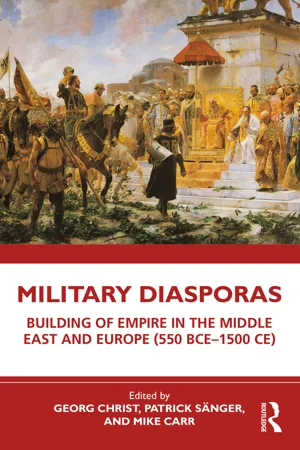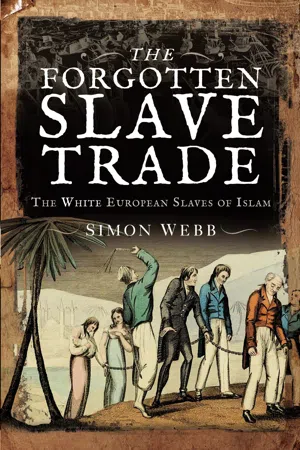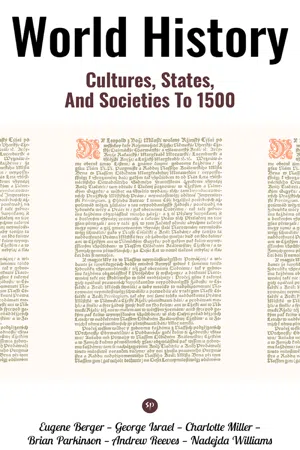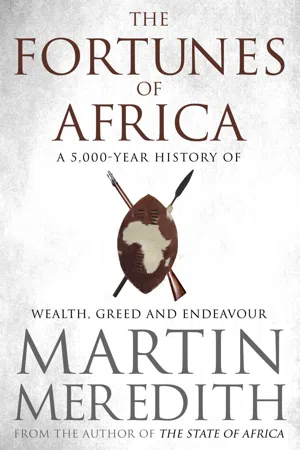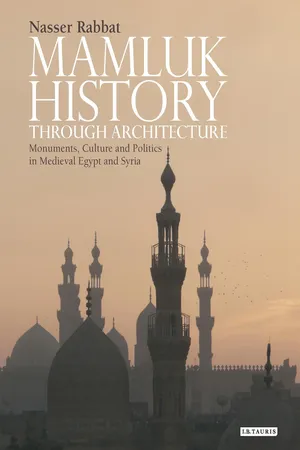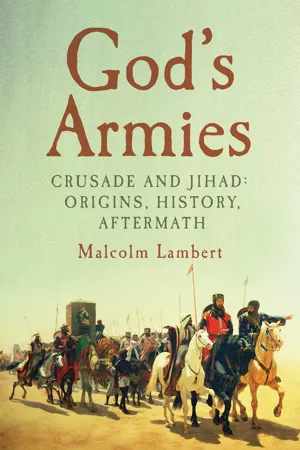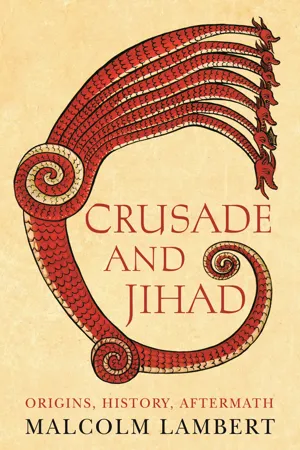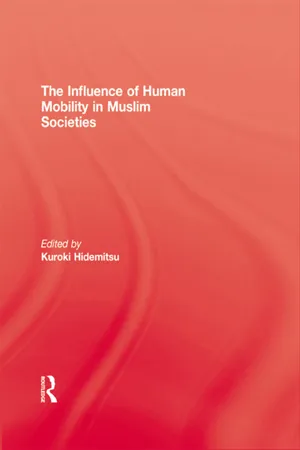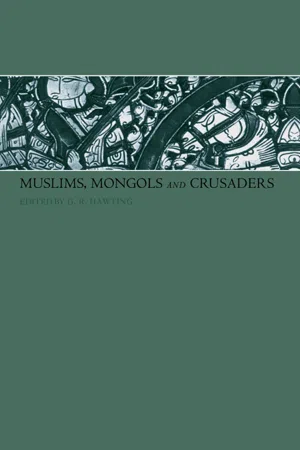History
Mamluks
The Mamluks were a military class of slave soldiers who ruled Egypt and Syria from the 13th to 16th centuries. Originally brought to the region as slaves, they eventually rose to power and established their own dynasty. The Mamluks were known for their military prowess and their significant impact on the political and cultural landscape of the Middle East.
Written by Perlego with AI-assistance
Related key terms
12 Key excerpts on "Mamluks"
- eBook - ePub
- Michael Winter(Author)
- 2003(Publication Date)
- Routledge(Publisher)
1 Generally, it was not ruled by a dynasty, but by an oligarchy of soldiers, Mamluks, or enfranchised military slaves. The Mamluks were white slaves who were bought, raised, and then trained as elite troops. They were born outside the Islamic domain, usually in the Euro-Asian steppe, north of the lands of Islam or in the Caucasus, to non-Muslim parents preferably of Turkish stock, and were imported when still boys or adolescents by the slave traders. The system of Mamluk military slavery had been practised from early times in Islam; it entrenched itself during the reign of the .Abbasid Caliph al-Mu‘tasim (833–42) and then spread throughout the Islamic lands.Al-Malik al-Salih purchased Mamluks in large numbers, a policy which prepared the ground for the eventual Mamluk takeover of the state. The phenomenon of former slaves replacing their masters was unprecedented and left the Mamluks vulnerable. They needed to legitimize their rule and eliminate the remaining Ayyubids. Their chance came after they trounced the seemingly invincible Mongols at .Ayn Jalut in Palestine (1260). Al-Malik al-Zahir Baybars (1260–77) then brought to Cairo a scion of the .Abbasid caliphs of Baghdad, after that dynasty had almost been wiped out during the devastating Mongol occupation of the city in 1258, thus giving to his rule an aura of legitimacy.Baybars, the founder of the Mamluk Sultanate, was an exceptionally able ruler and general. He transformed Egypt, Syria and the Hijaz into a stronger and more cohesive unit. This vigorous regime later put an end to the presence of the Franks in the east (the reconquest of Acre, 1291) and pushed the Mongols back beyond the Euphrates. Defended by the superb Mamluk horsemen, the new Sultanate constructed social and religious life on the principles of Sunni orthodoxy, continuing the religious policy of the Ayyubid dynasty. It patronized learning and piety, organized and protected the annual caravan of pilgrims to Mecca and Medina, and erected magnificent monuments in the major Egyptian and Syrian cities. These and other achievements were financed by the revenue from agriculture and international commerce, primarily the lucrative Eastern spice trade that passed through the Sultanate en route to Europe. - eBook - ePub
Military Diasporas
Building of Empire in the Middle East and Europe (550 BCE-1500 CE)
- Georg Christ, Patrick Sänger, Mike Carr(Authors)
- 2022(Publication Date)
- Routledge(Publisher)
military slaves, were professional soldiers, theoretically born outside the Islamicate world, that is in the “abode of war” (dār al-ḥarb), enslaved in childhood and trained to serve their master who manumitted them upon completing their military training and entering adulthood. 2 The institution of military slavery dates to late ninth-century Iraq, where the Abbasid caliphs tried to free themselves from their entourage by relying on forces of undivided allegiance directly depending on their person. 3 In 1250, the last Ayyubid sultan of Egypt was murdered by the mamluk officers of his father, who provisionally placed the widow of their former master on the throne. These Mamluks soon designated one of their own to act as sultan: And thus a new political regime was born. In the fourteenth- and fifteenth-century Egypt and Syria, the role played by (mainly autochthonous) civilian élites in the management of the state, the integration of non-mamluk individuals into the military aristocracy, as well as the room made in the army for freeborn soldiers of various ethnic identities, has been well emphasized by recent scholarship. 4 Although the role of the Mamluks in the state has been recently reconsidered, historians still commonly refer to the polity born in 1250 as the Mamluk sultanate of Egypt and Syria, because of the Mamluks’ deep imprints on the state and the country - eBook - ePub
The Forgotten Slave Trade
The White European Slaves of Islam
- Simon Webb(Author)
- 2020(Publication Date)
- Pen & Sword History(Publisher)
George Santayana once remarked that those who do not remember their history are doomed to repeat it and nothing could be more apposite when we observe what happened in the Ottoman Empire. Although most of us have heard of the Ottoman Empire, the meaning of the word ‘Ottoman’ is likely to be obscure and so a brief explanation might be helpful. ‘Ottoman’ is an Anglicised corruption of Osman, who founded a nation in what is today Turkey. Osman was himself Turkish, although his family actually came from Central Asia, fleeing attacks from the Mongols. It has been suggested that Osman I, who founded the Ottoman Empire, would actually have been called Attman, more in keeping with his Turkish origins, and that he is known as Osman because that name sounds more Arabic. Whatever the truth of the matter, at the end of the thirteenth century Osman founded his own country in a corner of the Anatolian plateau of central Turkey. Over the centuries, this nation expanded into a mighty empire which reached from the Afghanistan in the east almost to the Atlantic in the west. The general term, both for the empire and those who ruled it, was Ottoman.Many of the early Mamluks were of course Turkish and their recruitment ended in a Mamluk dynasty which lasted for centuries. One might have thought that if any group would be able to benefit from studying this historical episode, it would have been the Turks themselves. Having seen the corrosive effect which the rise of the slave- soldiers had on existing systems of government, one might assume that they would be careful not to fall prey to the same foolish desire for a special corps of soldiers, fanatically devoted only to one leader. It might further be guessed that the inherent dangers of raising slaves to a position of such military importance would be glaringly obvious to the Turks. One would be quite wrong.Because slaves were such an important commodity in Muslim countries at that time, like gold, spices or ivory, they were taxed by the government. In the case of slaves, taxation was in kind; that is to say, anybody importing slaves was liable to hand a certain proportion of them over to the ruler. Sometimes this was the sultan of the Ottoman Empire, but in the provinces of North Africa, the local governor might take his own cut. This meant that between a fifth and an eighth of the slaves brought into the Muslim world from Europe and Africa ended up as the property of the state rather than any individual owner. Some were, or became, eunuchs, others were concubines and a number ended up as galley slaves. Fifty years after Osman I founded his new country, it struck one of his successors as a good idea to start building up a personal bodyguard, a little like the Praetorian Guard of the Romans and very similar to the Mamluks, whose creation had caused so much trouble in the Arab world. His aim was recruit men loyal only to him, who would protect him from the troops of any discontented nobles or tribal chiefs. This unit was called the Yeni Ceri - Eugene Berger, George Israel, Charlotte Miller, Brian Parkinson, Andrew Reeves, Nadejda Williams(Authors)
- 2018(Publication Date)
- Studium Publishing(Publisher)
Indoctrinated at a young age, Mamluks remained loyal to their leaders, serving as their personal bodyguard. Once emancipated, however, they entered into a contractual relationship with their former masters and benefited from certain property and marriage rights. Although often portrayed as slaves in the popular imagination, Mamluks actually formed a proud caste of soldiers who considered themselves superior to the rest of society. As the elite bodyguards to the caliph, they supplanted the traditional ethnic hierarchy of the ‘Abbasids, a shift which led to much class conflict often resulting in unrest and civil disturbances. In order to remove the Mamluks from the volatile situation in Baghdad, the caliph moved the capital to Samarra, some 60 miles to the north, a measure that only delayed the inevitable, as subsequent caliphs could not control the rising tensions that resulted in social instability and contributed to the decentralization and fragmentation of the empire. The transition from tribal armies to Mamluks had profound repercussions for the ‘Abbasids. Mamluks like Ahmad ibn Tulun (835 – 884), a slave from Circassia, most exemplified this pattern of decentralization and fragmentation that had disastrous consequences for the ‘Abbasid Caliphate. He had been sent by the ‘Abbasids to Egypt in order to restruc ture and strengthen it on their behalf. An intellectual and religious person, ibn Tulun founded schools, hospitals, and mosques in Egypt, the most famous being the eponymous ibn Tulun Mosque. However, he saw weakness back in Baghdad, as the ‘Abbasids suffered from instability, including palace intrigue, disorderly Mamluks, and revolts like the Zanj Rebellion, a slave rebellion that threatened the fate of the caliphate. The ‘Abbasids could not control ibn Tulun, and, as the caliphate broke down, he managed to secure almost complete autonomy from Baghdad- eBook - ePub
Fortunes of Africa
A 5,000 Year History of Wealth, Greed and Endeavour
- Martin Meredith(Author)
- 2014(Publication Date)
- Simon & Schuster UK(Publisher)
PART IV 14 Mamluks AND OTTOMANS S hortly after Salah al-Din ibn Ayyub took control of Cairo in 1171, he chose a new site for the seat of government, building a fortress known as the Citadel on a promontory beneath the Muqattam hills which gave him a commanding view of the city. In an area just below the Citadel he laid out a parade ground where his troops gathered for military exercises and sporting activities, including games of polo. For the next 700 years, Egypt was ruled from the Citadel. The Ayyubid dynasty founded by Salah al-Din came increasingly to rely on the services of a caste of elite slave soldiers called Mamluks recruited from the Eurasian steppes and the Caucasus to provide military backbone. Mamluks had bolstered the armies of several Islamic rulers since the ninth century. Sold by their families and separated from their homeland, they owed total obedience to their patrons. Because of their loyalty, mamluk amirs or commanders often rose to high positions in government. Their role in Egypt became even more important as a result of threats that Ayyubid rulers faced both from Crusader armies and from approaching Mongol hordes. When French invaders landed in Egypt in 1249, a mamluk regiment played a decisive role in their defeat. The following year, mamluk amirs seized power and established their own sultanate. The Mamluk sultanate became a self-perpetuating military oligarchy that lasted for more than 260 years. To fortify their numbers, mamluk amirs used Muslim merchants to purchase youths from Turkic tribes north of the Caspian Sea who were brought to Cairo, given rigorous training in Islam and in military skills, notably horsemanship and archery, then freed to become professional soldiers in cavalry regiments. Military schools instilled into the youths a strict code of obedience and discipline and a clear sense of hierarchy - eBook - ePub
Islam and the Abode of War
Military Slaves and Islamic Adversaries
- David Ayalon(Author)
- 2022(Publication Date)
- Routledge(Publisher)
IIMAMLŪK MILITARY SLAVERY IN EGYPT AND SYRIA
sThis study was published in an abridged form in The Encyclopaedia of Islam (2nd edition), VI fasc. 103-104 (1987). The full version, published here for the first time, gives a more comprehensive picture of Mamlūk military slavery in Egypt and Syria under the Mamlūk sultanate.Islamic military history and organization have not received, until very recently, even part of the attention they deserve. This in spite of the immersion of the Muslim historical sources in the subject, and in spite of its objective centrality in shaping the fate of Islam throughout its existence. This affirmation is even truer of the Mamlūk military institution, which constituted the heart and core of the military might of most of the major Muslim states during the greatest part of Islam’s existence, and without which that religion’s chances of becoming a world religion on its present scale and within its present boundaries would have greatly diminished.For the purpose of laying the foundation of the study of the Mamlūk phenomenon in Islam, the Mamlūk sultanate (648-922/1250-1517)is by far the best choice, because of the richness and variety of its historical sources; because so many of them are contemporary with the events they describe, and because they contain so many definitions and descriptions of that state’s institutions. The reconstruction of military slavery under the Mamluks is bound to shed much light on practically every Mamlūk society in Islam, before, during and after the Mamlūk sultanate. However, to use what we know about the Mamlūk sultanate to draw conclusions about other reigns, of which we know less, should be done only with great caution, because of the differences in circumstances, as a systematic study will show time and time again. The abundance of definitions and descriptions, though basically most welcome, does also have its grave dangers, for so many of them are either partial or inaccurate or true only for the author’s time. They have, therefore, to be constantly checked by independent, preferably unconscious, evidence. - eBook - ePub
Mamluk History through Architecture
Monuments, Culture and Politics in Medieval Egypt and Syria
- Nasser Rabbat(Author)
- 2010(Publication Date)
- I.B. Tauris(Publisher)
20 The Mamluks were thus compelled to pat-ronise and employ the literati to manage the sultanate and maintain its religious, social and fiscal systems. However, they kept them under constant check, enforced with the real threat of confiscation, arrest and sometimes exceedingly brutal punishment.This paradoxical situation affected the ways in which the literati saw their relationship with the Mamluk ruling class, from whose ranks they were banished but to which they were financially, politically and even existentially beholden. It translated into an attitude of uneasy acquiescence laced with jealousy and an affected haughtiness, that found their way into all genres of writing of the time, but especially historical/biographical texts.The Mamluks were the rulers to fear and the patrons to please: they had to be presented in a positive light. The praise often comes across as transparently perfunctory, however, especially in the official, commissioned annals, such as the three encomia for Baybars, Qalawun and al-Ashraf Khalil, written by Ibn ‘Abd al-Zahir (1223–1292), who held high chancery positions under all three.21 More sincere and heartfelt were the representations of the Mamluks, particularly the founders from Qutuz to al-Ashraf Khalil, as the heroes of jihad who defended Islam against its enemies: the Crusaders, the Mongols, the Armenians and some domestic splinter groups.22 This loudly and justly celebrated achievement, however, did not obfuscate the frequent though prudently subdued discontent with the Mamluks as a ruling class. Mamluks were the manipulators of financial rewards and public office coveted by many literati and, in the final account, the outsiders who had seized and maintained power by force.Thus, from the early days of the regime, the Mamluks’ military and equestrian qualities were seen as both the source of their success and the tools of their coercion, and therefore grounds for both admiration and apprehension. The castigation became louder and more explicit in the fifteenth century, when the Mamluks began, for various reasons, to neglect their political and religious duties. Contemporary observers no longer saw them as the deserving leaders they had once been, skilfully and thoughtfully managing a great empire and fighting for the cause of Islam.23 - Peter Jackson(Author)
- 2023(Publication Date)
- Routledge(Publisher)
The Medieval History of Iran, Afghanistan and Central Asia (London, 1977).2 David Ayalon, “Preliminary remarks on the Mamlūk military institution in Islam”, in V. J. Parry and Μ. E. Yapp (eds), War, Technology and Society in the Middle East (Oxford, 1975), pp. 44-58, repr. in his The Mamlūk Military Society (London, 1979); Patricia Crone, Slaves on Horses: the Evolution of the Islamic Polity (Cambridge, 1980); Daniel Pipes, Slave Soldiers and Islam: the Genesis of a Military System (New Haven and London, 1981); Bosworth, “Barbarian incursions”, pp. 4-10.The Delhi state too has been designated as a “Mamlūk Sultanate” with regard to the first nine decades of its history. It was founded by mamlūks: Qutb al-Dīn Aybeg, one of the numerous Turkish slaves whom the Ghurid Mu’izz al-Dīn is known to have accumulated,3 and Aybeg’s own slave Shams al-Dīn Iltutmish. For much of the seventh/thirteenth century it rested upon an élite corps of Turkish mamlūks, who largely provided the military leadership, the provincial governors and the great officers of state. It is of course misleading to speak of Mamlūk or Slave “dynasties” at either Cairo or Delhi. Only one Egyptian Mamlūk sultan, the formidable Qalāwūn (d. 689/1290), whose descendants governed Egypt and Syria, with two brief intervals, down until 784/1382, can be said to have founded a dynasty.4 In Delhi, prior to the so-called “Khaljī revolution” (which, by an odd yet totally meaningless coincidence, occurred in the very year that Qalāwūn died), the throne had been occupied first by Iltutmish and his descendants (607-664/1211-1266) and then by Iltutmish’s former mamlūk- eBook - ePub
God's Armies
Crusade and Jihad: Origins, History, Aftermath
- Malcolm Lambert(Author)
- 2016(Publication Date)
- Pegasus Books(Publisher)
Ottomans evolved from Turkish war bands in Anatolia and gained prestige when they captured Constantinople in 1453. They defeated the Mamluks of Egypt in 1517. The legend persists that Ottomans defeated Mamluks because they knew how to use gunpowder while their more hide-bound opponents declined to keep up with the times. Robert Irwin has demonstrated that this is untrue. The curved bow was superior to the handgun for Mamluk cavalry. If the horsemen were well trained, their bows could fire off six shots per minute while handguns of the time could only achieve one to two shots. Handguns were useless to men in the saddle; they might, in contrast, be handed out to low-grade infantry who lacked horsemanship and the training needed to draw back the curved bow. Both sides at various times used cannon and handguns, but they were not in themselves decisive. Ottomans won because Mamluk leadership had grown decadent and because they had developed one military technique, the defensive chained wagon, which the Mamluks never mastered.One harsh military dictatorship based on slave soldiers, the Janissaries, succeeded a previous such dictatorship, to the detriment of Islam. The breakdown of Iraq’s irrigation system ruined the civilisation based on it. Baghdad ended as a dull provincial town, shorn of intellectual life. It is true that the cultural life of the Mamluks can be underestimated. They were willing to use a great historian, Ibn Khaldun, as a tutor to a boy sultan. They were ultimately responsible for a wide range of Arabic writing and were patrons for one work of world literature, the Thousand and One Nights. They left their mark on Jerusalem, and architecturally it was a good one. Christian sites were not demolished because they brought in pilgrim traffic and Islamic ones were cherished. Sultan Qaitbay, who reigned from 1468 to 1496, was responsible for a masterpiece of intricate stonework, the ablutions tower placed west of the Dome of the Rock, which still fascinates tourist and pilgrim.Yet military success was purchased at a high price, and in this respect Mamluk and Ottoman dictatorships were alike in that they were similarly systems of arbitrary rule, stifling any developments in the heartlands of Islam similar to the effects in England of counsel and consent on kingship, and the emergence of bargaining power on the side of the Commons to mitigate the power of kings. The message of Mamluk and Ottoman alike was that only despotism paid, to the great detriment of Muslims down to modern times.* A masterly analysis of the site and sequence of events is in P. Herde, Gesammelte Abhandlungen und Aufsätze - eBook - ePub
Crusade and Jihad
Origins, History, Aftermath
- Malcolm Lambert(Author)
- 2016(Publication Date)
- Profile Books(Publisher)
Ottomans evolved from Turkish war bands in Anatolia and gained prestige when they captured Constantinople in 1453. They defeated the Mamluks of Egypt in 1517. The legend persists that Ottomans defeated Mamluks because they knew how to use gunpowder while their more hidebound opponents declined to keep up with the times. Robert Irwin has demonstrated that this is untrue. The curved bow was superior to the handgun for Mamluk cavalry. If the horsemen were well trained, their bows could fire off six shots per minute while handguns of the time could only achieve one to two shots. Handguns were useless to men in the saddle; they might, in contrast, be handed out to low-grade infantry who lacked horsemanship and the training needed to draw back the curved bow. Both sides at various times used cannon and handguns, but they were not in themselves decisive. Ottomans won because Mamluk leadership had grown decadent and because they had developed one military technique, the defensive chained wagon, which the Mamluks never mastered.One harsh military dictatorship based on slave soldiers, the Janissaries, succeeded a previous such dictatorship, to the detriment of Islam. The breakdown of Iraq’s irrigation system ruined the civilisation based on it. Baghdad ended as a dull provincial town, shorn of intellectual life. It is true that the cultural life of the Mamluks can be underestimated. They were willing to use a great historian, Ibn Khaldun, as a tutor to a boy sultan. They were ultimately responsible for a wide range of Arabic writing and were patrons for one work of world literature, the Thousand and One Nights. They left their mark on Jerusalem, and architecturally it was a good one. Christian sites were not demolished because they brought in pilgrim traffic and Islamic ones were cherished. Sultan Qaitbay, who reigned from 1468 to 1496, was responsible for a masterpiece of intricate stonework, the ablutions tower placed west of the Dome of the Rock, which still fascinates tourist and pilgrim.Yet military success was purchased at a high price, and in this respect Mamluk and Ottoman dictatorships were alike in that they were similarly systems of arbitrary rule, stifling any developments in the heartlands of Islam similar to the effects in England of counsel and consent on kingship, and the emergence of bargaining power on the side of the Commons to mitigate the power of kings. The message of Mamluk and Ottoman alike was that only despotism paid, to the great detriment of Muslims down to modern times.Footnote1 A masterly analysis of the site and sequence of events is in P. Herde, Gesammelte Abhandlungen und Aufsätze vol. 2, pt I - Kuroki Hidemitsu(Author)
- 2013(Publication Date)
- Routledge(Publisher)
Turks in the Political and Military Lifeof Eleventh-Century Egypt and SyriaTurkish Military Slaves and Bedouin ChiefsYaacov LEVMuslim military slavery is a well-known institution. However, the people who experienced it, Turks and Africans, are known only if they attained a position of significance in the lands of Islam. The vast majority of them were regarded as a nameless and faceless mass by Muslim medieval society and have remained as such for us. The background of these people, even of those who earned fame in the lands of Islam, was in most cases utterly obliterated. Very rarely do the sources provide any information that reflects an interest among the Muslim civilian elite, a class composed of administrators and men of religion, in the background of the foreign emirs of the military class who came to dominate the political life of Islam after the second half of the ninth century. For example, the historian Ibn Zafir (1171–1226) says that Abu Bakr Muhammad Ibn Ali of the renowned Madhara i family of Egyptian administrators of the tenth century, once asked Kafur about his African past and how he was brought as a slave to Egypt. Kafur answered that he was brought at the age of fourteen and the historian adds that it was in the year 322 A.H./934 A.D. One can doubt that such a question was ever asked, but it betrays a curiosity by a member of the civilian elite about the master of the country, the eunuch Kafur, who independently ruled Egypt in the fifth and sixth decades of the tenth century. Kafur’s alleged answer seems improbable. Usually castration was performed on very young boys, certainly under the age of fourteen. But the traumatic experience must have haunted the lives and memories of the victims. Another way of looking at this account is that Kafur meant that at the age of fourteen he was put on sale at the slave market. But one must ask oneself whether people enslaved in their early boyhood would have had any knowledge of their age.1- eBook - ePub
- Dr Gerald Hawting(Author)
- 2012(Publication Date)
- Routledge(Publisher)
1A second passage of Poliak’s reads: ‘In view of the fact that the Mamluk sultans and Amirs married into the principal families of Circassia, and were doubtless aided by their relatives, who had remained in the home country, one is led to believe that the ruling power was practically held by the same group in Circassia and the Mamluk kingdom. This group is called in the Mamluk sources al-qarānīṣ, al-qarāniṣa , sing. qirnāṣ . The qarānīṣ were represented in the diverse ranks of the military hierarchy, but were everywhere held in greater esteem than their colleagues, even their superiors, and were the first candidates for promotion. Thus one Amir recommended Ṭaṭar (who later became sultan) to the sultan as qirnāṣ , while Ṭaṭar was still an unliberated mamluk. There were also qarānīṣ among the mamālīk sulṭānīya , i.e. the freed Mamluks who were in the service of the sultan. A small and special corps was called al-ajnād al-qarānīṣ ; its members were candidates for the amirate and holders of large fiefs (arzāq ), and their social position was similar to that of Amirs of Five. This corps was composed of men who had served in the Mamluk kingdom for a long time. Naturally, there were qarānīṣ also among the julbān , the recently arrived Mamluks. Needless to say, they were represented also among the amirs, and here also, it was the fact of belonging to this nobility more than the military rank which determined the amir’s social standing. The governor of Jerusalem, Khushqadam as-Sayfī (d. 853 A.H. ), in spite of his bravery, “ did not belong to the notables and to those who are the chiefs of their compatriots ”, while a private soldier (jundī ), Lājīn (d. 804 A.H. ), was considered by the Circassians and even the amirs a certain candidate for the sultanate. The qirnāṣ did not need to wear fine clothes or ride handsome horses in order to gain high esteem but, on the contrary, many of them (i.e. the qarānīṣ ) thought it an honour to be distinguished by old and tattered garments. I know of no case in which an ibn nās was called qirnāṣ . It is interesting to note that even in al-Jabartī’s chronicle, which was very much influenced by the language of the Mamluk sources, we meet the word al-qarānīṣa in the sense of “ high amirs ”. Just as they (the qarānīṣ ) constituted the aristocracy of the Circassians, so the Circassians formed the aristocracy of the “ Turks ”,2 among whom the proportion of other races was considerable’.3
Index pages curate the most relevant extracts from our library of academic textbooks. They’ve been created using an in-house natural language model (NLM), each adding context and meaning to key research topics.

